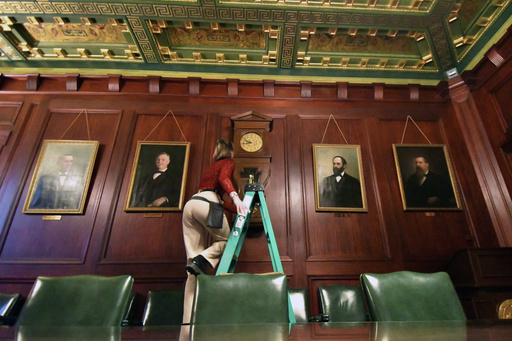
HARRISBURG, Pa. — Capitol structures often convey a sense of grandeur, characterized by their stately design and prominent dome. The Pennsylvania Capitol stands out with its remarkable artwork, smooth marble finishes, and elaborate carvings, but it houses an often overlooked gem: hundreds of antique clocks integrated within its original architecture.
This remarkable collection consists of 273 functional clocks, many of which are cleverly incorporated into the building’s fireplace mantels and other structural elements. These historical timepieces require considerable upkeep, necessitating regular oiling and periodic mechanical repairs. On a weekly basis, skilled clock winders traverse the hallways, ensuring these century-old devices continue to measure time accurately, in a nod to an era predating modern wristwatches and smartphones.
Recently, Bethany Gill showcased her expertise in clock maintenance, skillfully navigating various rooms with specialized ladders and tools. She delicately lifts glass covers, methodically winds the mechanisms to propel them for another week, and verifies their precision before progressing to the next clock. Gill, who is associated with Johnson & Griffiths Studio—a Harrisburg-based company that recently renewed its five-year, $526,000 contract with the Capitol Preservation Committee—has a deep passion for clocks. Her enthusiasm is reflected in her enjoyment of the biannual shifts between daylight saving time and standard time.
“My father was an avid clock enthusiast during my childhood,” Gill reminisced. “Each Sunday, we would make a ritual of winding the clocks together, and it became a cherished tradition between us.”
Architect Joseph M. Huston designed Pennsylvania’s Capitol after winning a design competition in 1901, driven by his vision of creating a “temple of democracy.” He sought to develop a building that rivaled the grandeur found in Europe. Among his many artistic elements, Huston crafted at least 180 unique clock cases, including smaller models dubbed “keystone clocks” to celebrate Pennsylvania’s pivotal role in American history, ultimately earning the state its nickname, the Keystone State.
“The clocks significantly contribute to the Capitol’s uniqueness and complexity,” stated Jason Wilson, a historian from the Capitol Preservation Committee. “The elaborate mantels framing the clocks are also custom-designed.”
From time to time, the clocks, predominantly constructed from mahogany or stained mahogany, are carefully transported from their designated locations within the Capitol to a specialized facility for cleaning and repair. Keeping them wound enhances their operational efficiency.
Huston’s architectural vision succeeded in creating a magnificent centerpiece that attracts thousands of visitors annually, where 253 state legislators gather to discuss and legislate important state matters. While the existence of these clocks and the Capitol itself remains Huston’s lasting legacy, it is noteworthy that he was later convicted of conspiracy to defraud the state during the Capitol’s construction and spent several months at the iconic Eastern State Penitentiary in Philadelphia.

